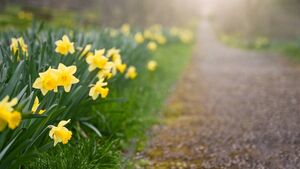Green Fingers: Have a light bulb moment

I put bulbs in places where they can flower undisturbed for years.
Everyone loves spring flowering bulbs and yet their popularity is waning and it is not because of their cost, as they are as cheap as a can of budget baked beans.
The real reason is that the newer breed of people are used to instant impact and do not realise that to have flowers from bulbs they must be planted about six months earlier.
I find it a pity that more are not planted as they bring such joy from late winter and early spring when most other plants are dormant and not flowering. It is not as if there is a lack of publicity out there to plant bulbs but it is just that attitudes have and are constantly changing.
I would just say if you see bulbs for sale go out and plant some and if you get excited then head out and search out the more unusual varieties in a local garden centre.
When you get your bulbs home, either plant them straight away or put them in full view so you are constantly reminded of them, as many are put aside and forgotten until next spring when it is too late.
As a guide bulbs need to be planted about double the depth of their size and I put them in places where they can flower undisturbed for years rather than in beds that I will plant up with summer flowers next spring.
Another point to bear in mind is that when finished flowering they take a longish period for the leaves to die down, so plant them where that does not matter that much if possible.
The large flowering daffodils are also called narcissi but we tend to only call the dwarf varieties by the latter name. The larger flowering types are typically planted out in groups in shrub beds or along boundaries, while the dwarf types are planted near the home, by the patio or in containers.
Some of our favourite daffodils include ‘Golden Harvest’ (yellow) and ‘Mount Hood’ (white), while the ‘Pheasant Eye’ and ‘Geranium’ would be our choice for fragrant varieties.
The dwarf narcissi types such as ‘Minnow’ (yellow and white) and ‘Tete-a-Tete’ are two of the pretty types.
There are also tall and dwarf types in this section and they are treated in the same way as described above with narcissi. There are so many varieties available it is hard to choose between them but choose what shapes and colours you like and you cannot go far wrong.
Taller types would include ‘Purissima’ (white), ’Queen of Night’ (purple black) and a good red called ‘Red Impression’ and dwarf types such as ‘Little Red Riding Hood’, ‘Verdi’ (yellow/red), ’Pinocchio’ (red/white) and ‘Gold West’ (yellow).
If you would like some unusual types try ‘Rococo’ (cardinal red), ‘Salmon Beauty (orange) and ‘Arabian Beauty’ (lilac/yellow).
I do often wonder just how small bulbs manage to not only survive but thrive in our gardens but then I realise that it is these that have been developed from the wild and that the larger varieties bred by humans are less hardy.
Snowdrops once established are very long-lasting and are brilliant, followed by the popular crocus, which comes in a multitude of colours.
Check your vegetables twice a week and harvest them as they become ready; otherwise they will stop producing overnight and that is the end of the growing season. Crops such as parsnips, leeks and Brussels sprouts are happy to stay in the ground until needed.
If you have any queries or comments you are welcome to share them with me on 051-384273 or orchardstowngardencentre@hotmail.com and if of general interest I will include it in a future article.






